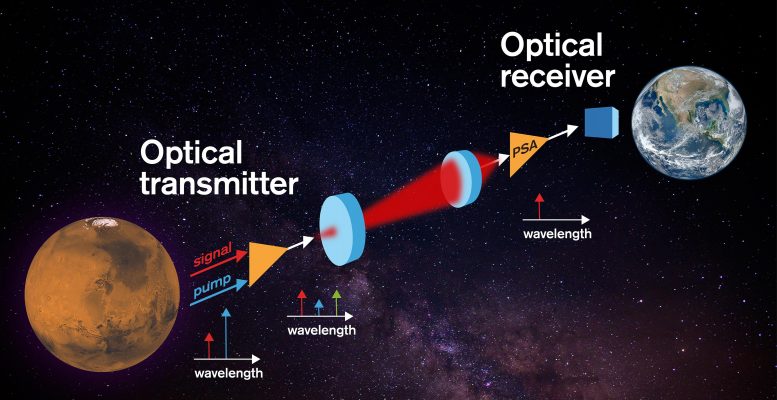
Communications in space demand the most sensitive receivers possible for maximum reach, while also requiring high bit-rate operations. A novel concept for laser-beam-based communications, using an almost noiseless optical preamplifier in the receiver, was recently demonstrated by researchers at Chalmers University of Technology, Sweden.
In a new paper published in the scientific journal Nature: Light Science & Applications, a team of researchers describes a free-space optical transmission system relying on an optical amplifier that, in principle, does not add any excess noise — in contrast to all other preexisting optical amplifiers, referred to as phase-sensitive amplifiers (PSAs).
The researchers’ new concept demonstrates an unprecedented receiver sensitivity of just one photon-per-information bit at a data rate of 10 gigabits per second.
“Our results show the viability of this new approach for extending the reach and data rate in long-distance space communication links. It therefore also has the promise to help break through the present-day data-return bottleneck in deep-space missions, that space agencies around the world are suffering from today,” says Professor Peter Andrekson, head of the research group and author of the article together with PhD Ravikiran Kakarla and senior researcher Jochen Schröder at the Department of Microtechnology and Nanoscience at Chalmers University of Technology.

Substantially increasing the reach and information rate for future high-speed links will have big implications for technologies such as inter-satellite communication, deep-space missions, and earth monitoring with light detection and ranging (Lidar). Systems for such high-speed data connections are increasingly using optical laser beams rather than radio-frequency beams. A key reason for this is that the loss of power as the beam propagates is substantially smaller at light wavelengths, since the beam divergence is reduced.

Nevertheless, over long distances, light beams also experience large losses. For example, a laser beam sent from the Earth to the Moon — around 400,000 kilometers (250,000 miles) — with a 10 cm (4 in) aperture size, will experience a loss of power of around 80 dB, meaning only 1 part in 100 million will remain. As the transmittable power is limited, it is of critical importance to have receivers that can recover the information sent with as low power received as possible. This sensitivity is quantified as the minimum number of photons per information bit necessary to recover the data without error.
In the new concept from Chalmers, information is encoded onto a signal wave, which along with a pump wave at different frequencies generates a conjugated wave (known as an idler) in a nonlinear medium. These three waves are launched together into the free space. At the receiving point, after capturing the light in an optical fiber, the PSA amplifies the signal using a regenerated pump wave. The amplified signal is then detected in a conventional receiver.
“This approach fundamentally results in the best possible sensitivity of any pre-amplified optical receiver and also outperforms all other current state-of-the-art receiver technologies,” says Peter Andrekson.
The system uses a simple modulation format encoded with a standard error correction code and a coherent receiver with digital signal processing for signal recovery. This method is straightforwardly scalable to much higher data rates if needed. It also operates at room temperature, meaning it can be implemented in space terminals and not only on the ground.
The theoretical sensitivity limits of this approach are also discussed in the paper and compared to other existing methods, with the conclusion that the new approach is essentially the best possible for a very broad range of data rates.
Reference: “One photon-per-bit receiver using near-noiseless phase-sensitive amplification” by Ravikiran Kakarla, Jochen Schröder and Peter A. Andrekson, 2 September 2020, Light: Science & Applications.
DOI: 10.1038/s41377-020-00389-2
Never miss a breakthrough: Join the SciTechDaily newsletter.
2 Comments
makes the ai secuirty based. humans only operation of such new exoitc weapons post beginning of verfiied solar beam era to kill off big oil.
holds up ai ar camera on laptop and smartphone in privacy mode to do data transfers and recharging them at the same time offline after flipping kill switches on both software and hardware sides on ai web cameras to transfer sensitive data wirelessly like medical files from mobile to pc side and vies versa or from other mobile devices using laser-fi/li-fi. flips open killswitch after auto wiping heath data post-transfer and making a hardware backup kills all software history/hardware traces to hardware backup of such data to watch cable tv wirelessly from a smartphone at 8k hdr in the hotel room or for playing games in 8k ai resolution enhanced like watching cable tv at 8k two minute papers did on youtube using the same past 2 ways from smart tv to mobile device/pc laptop after making the headset only come from my mobile device/pc laptop not from the tv.